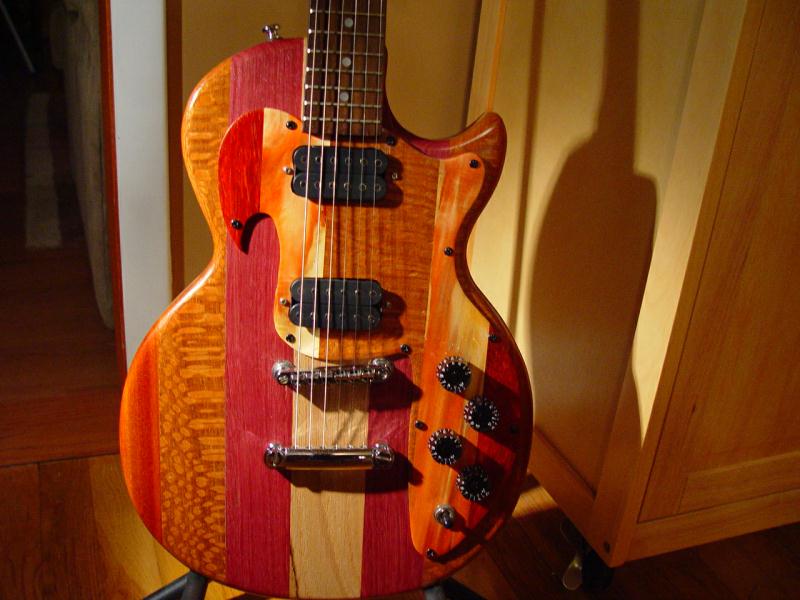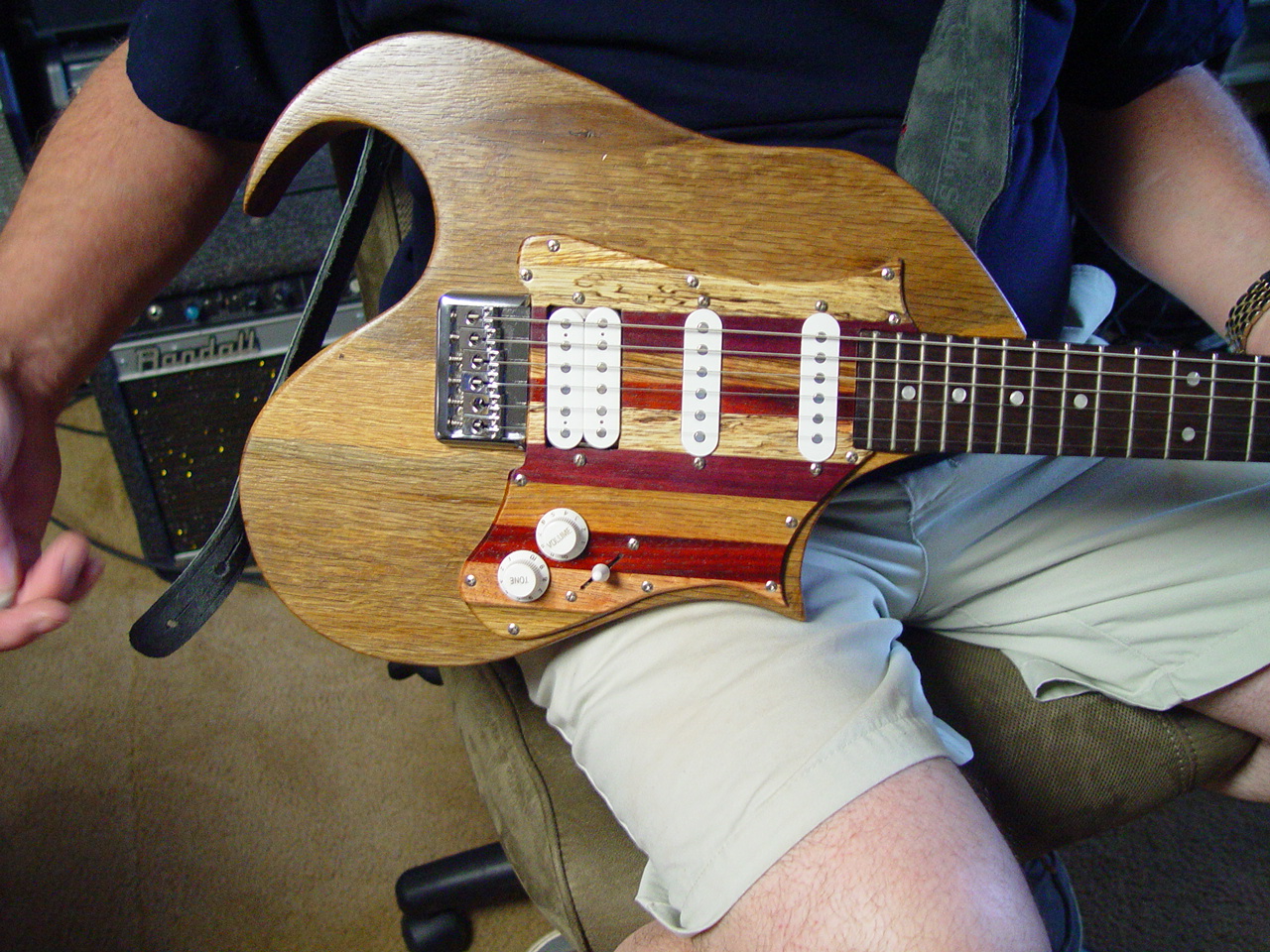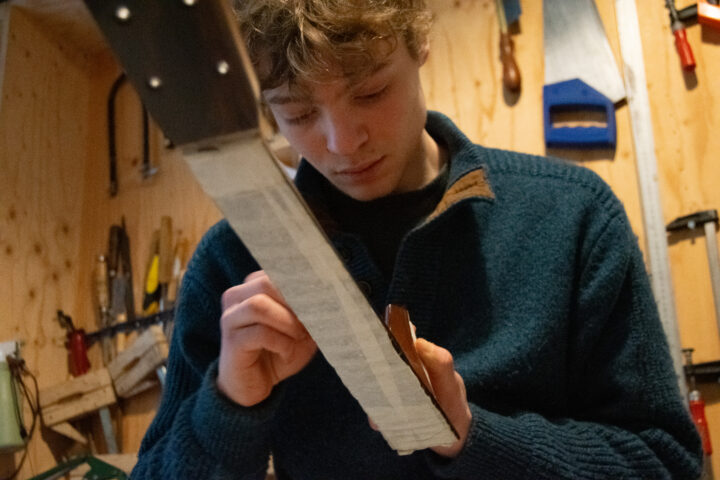In the Fall of 2009, it was time. I was turning 60 and finally ready to marry my love for an instrument I never properly learned with my nearly four decades’ experience of working with wood.
My guitar playing experience started in 1965 at the age of 15, when I bought a Danelectro Bellzouki from the only music store in Laramie, Wyoming. It was the 12-string teardrop model and, knowing nothing about how to play, the salesman tried everything to get me to buy a six string. But the jangles of those 12 strings were a siren song to me. I took it home and built a plug and cord to run it through my stereo. I tuned it, tried a few chords, tuned it some more and discovered that my parents were more interested in maintaining their alcohol habit then in paying for guitar lessons. Defeated, I sold it off a couple of months later.
In 1971, just married, I used my ever growing woodworking skills to take on commissions in an attic shop in our bungalow. An upside down circular saw mounted to a wooden bench served as my first “table saw.” My wood came from Saturday sales at a veneer plant in Norfolk, Virginia, where we lived. I built everything from tool chests to chairs to end tables. In 1975, when we moved to the Poconos the exotic woods were left behind.
Looking at the geography, it was obvious that refinishing was where the money was. So in 1976 I began a 12 year run owning and operating a refinishing service that consistently had a minimum 90 day backlog. I started with one partner who did not work out and took on a good, hard-working friend. We refinished everything from simple chairs to grand pianos. The work was non-stop. We were written up in a two page article by the local Clarks Summit, Pennsylvania newspaper.
It was during this time that my youngest son showed an interest in guitar, so I made time to take lessons with him. We bought acoustic guitars. We both showed interest in learning the instrument, but we never really liked playing acoustic. Computers called him away and my woodwork continued to keep me busy. We ended the lessons and sold the guitars. I still have one of the training books we used, now a personal treasure.
In 1988, after all those years of paint stripper, lacquer thinner, spray guns and long evening hours, I looked at my friend and partner and said, “You want to keep doing this? We don’t need the money.”
His reply was, as usual, straightforward. “Hell, no, let’s shut it down.”
It took us a full four months to close down the refinishing business. Customers were mad. People offered obnoxious sums of money to keep us refinishing. But we had enough. The last piece we did was a phone booth from downtown London, brought back by some person long forgotten. I still remember how heavy it was.
The next few years I concentrated on building pieces to my liking, experimenting with lathe work, exotic shapes, almost anything but straight edges. I’ve always loved the possibilities of a set of French curves in your hands, letting the pencil line wander into something wonderful and beautiful. Round drop-leaf tables, sea chests with beautiful humps and many other pieces came off my bench from that period. Some were given away, some were kept. Between 2002 and 2004, I went through a divorce, and lost all of them, but not the knowledge nor the tools.
In 2005, now remarried, I went to Shanghai, China for 16 months to work for a furniture company. I saw even more examples of what a curvature can mean to a piece of wood. It was almost like the Chinese were reading my mind. While their new buildings were boringly straight, the shops were full of beautiful, curved items of all types. My faith in the non-straight edge world was reinforced. I bought a guzheng (Chinese harp) and a yang ch’in (like an overbuilt hammered dulcimer), both historical Chinese stringed instruments. Once again, I bought an acoustic guitar to try. This time all the basic chords came and I actually began to make progress. I also played some simple songs on the guzheng. But, being a child of the ’60s, acoustic was not my gig. I wanted an electric.
I returned to the United States in January 2007 and spent a year working on my motorcycle collection, mostly now gone.
In February 2008, I took the plunge and bought an inexpensive Yahama electric guitar and a Line 6 digital amp, low by the standards of most. But to me they sounded like heaven. I began to self-teach, practicing everyday. Soon, I would travel in the steps of most beginners: “Walk Don’t Run,” “Night Moves” and “Money for Nothing.” And blues … oh how I loved that single string bend that almost said the words for you! I progressed until that fateful day in September 2009.
While at my day job as a manager for the furniture company that sent me to Shanghai, a coworker of mine posed a question: Since I had almost four decades of woodworking experience and it was obvious I was never going to become a world-class guitarist, would I consider building a guitar?
At first it seemed almost silly. There were so many great luthiers out there, how could I possibly compete? But I did have 39 years of woodworking and essentially all the proper tools to hand craft a guitar. I went home and started carefully looking over my meager collection and asking myself questions.
What would I do differently?
What would make these better, short of looks?
How do the wood, strings and pickups on a solidbody really work in unison? Or do they?
I bought a few pawn shop guitars and tore them apart. I studied many books. I learned that the industry was not as high-tech as I had thought. Short of obvious CNC machines for mass production, I did not see a major improvement in anything. In fact, it seemed like most manufacturers were trying to race to the bottom on price to survive the now looming economic downturn. I decided I could do better.
After setting up my shop in a manner to build small, curved items like guitars, I started a list of what engineering changes I would make to produce a sound that would improve and impress players and keep the instrument beautiful. I had always learned in continuous improvement: that you do not reinvent the wheel, you just keep improving it. To me, basswood bodies and thick poly finishes might address weight and durability, but they had just the opposite effect on the sound. I wanted my guitars to look good and sound better.
But living in the middle class, my goal was not to create an instrument that would cost thousands of dollars. I wanted to bring the sound I envisioned to people who spend much less than $1000 for a guitar. It seemed to me that they represent about 90% of the buying public for the guitar industry. Those folks were my target, including all those guitarists who were outstanding players, but had not hit the big time. It turns out they are everywhere!
I decided that pickups mounted directly to a large piece of wood, or a sheet of laminated plastic, no matter what type, were not the answer. And I really did not believe that strings could vibrate a solid wood body or plastic pickguard efficiently enough to make a difference in the sound.
I put my pickups and controls in a very thin pickguard made of hardwoods, usually exotic. I mounted them directly over a large chamber routed out in the solidbody. My necks were bolt-on for two reasons: it didn’t make any difference since the sound was being created below the neck and it resulted in a more affordable guitar. Reasonable cost was always one of the goals. I would not build $1000 guitars.
In the end, I created a guitar with a tonal chamber below the pickups, with a solid 1/8″ pickguard mounted to the face of the body holding all electronics. The pickguard can vibrate ever so slightly with the strings, and the magnetic fields of the pickups vibrate along with it. This gave my guitars longer sustain and hotter attack.
I took the very first one into work to show the fellow who had challenged me weeks prior. He took it home for one evening and the next day offered me $400 for it. He said the sustain and ease of play was like nothing he had held. My wife had asked that I not sell the first one should I decide to build, so I turned him down.

To this day, most people don’t believe that I can build these guitars for so little and have them sound so good. Until they hold and play one. One bluegrass player from Kentucky came to see me. He was seventy four years old and had been through it all. I had just finished a guitar the night before. He played it and immediately said, “No way can this sound this good … got to be the amp.” I had eleven amps sitting there on the wall in my playing area, so I invited him to choose the one he would prefer. He picked a 100-watt Fender Frontman set on the overdrive channel. We set it up and he played. He then looked up at me and said, “How much to buy this guitar?” I made $400 that day. Not much compared to the world class luthiers, but to me, I put a wonderful sound into the hands of a 50 year veteran of Bluegrass who sounded like Chet Atkins. You cannot ask for more than that.
Since then, players in bands, session players and hobbyists have all bought my guitars. A few collectors, too. I still only charge what I think is fair. Many people tell me I am way too inexpensive, but I make my money. It’s the pleasure of having a person who can really play that excites me to this day. It is one of the few times in my life I am not “following the money.”
My guitars are babies to me, hand-built right down to the neck pocket. No two are ever alike. I do not have CAD, nor do I have a CNC machine. Just standard woodworking tools such as a planer, jointer, some routers, a table saw and lots of hand tools. And of course my set of French curves. I spray only nitrocellulose lacquer, but I do have a small bake oven for those who want some color on their guitar. My shop is small; it’s just me.
My pricing is simple. My shop rate is currently $20 an hour. I take the cost of all components and things like sandpaper, lacquer and a small dollar amount for tool wear. I add the hours I think any particular guitar will take to build (usually 10-14) and multiply it by 20. So, my guitars now price in the $400 to $700 range. I also setup and intonate completely after the build, and I guarantee that if the buyer does not like the guitar when they first play it, I will simply give them back all monies as long as they return the guitar in new condition. They currently sell as fast as I can build them.
Since I started in September, 2009, I have built 27 guitars. “For the Rest of Us” is my motto.
And the name? Well, it was to represent a huge wall of sound. Possibly an unfortunate name now, with recent news from Japan, but most customers agree that Tsunami Guitars are unique and do put out that “wall of sound.”
To learn more about Tsunami Guitars, visit www.tsunamiguitars.com. There is also a Facebook page for Tsunami Guitars here.
If you have a great story to tell about your life as a musician, builder, collector or you-name-it, share it with us at stories@fretboardjournal.com.



